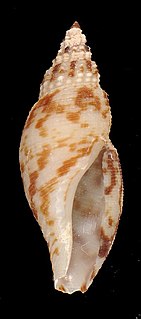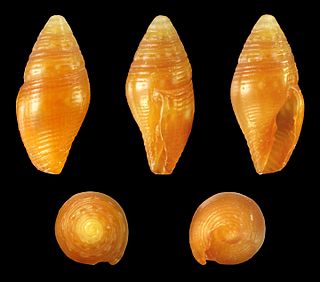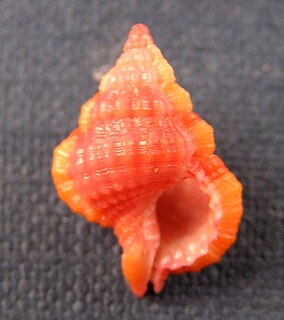
Tube-dwelling anemones or ceriantharians look very similar to sea anemones but belong to an entirely different subclass of anthozoans. They are solitary, living buried in soft sediments. Tube anemones live inside and can withdraw into tubes, which are composed of a fibrous material made from secreted mucus and threads of nematocyst-like organelles known as ptychocysts. Ceriantharians were formerly classified in the taxon Ceriantipatharia along with the black corals but have since been moved to their own subclass, Ceriantharia.

Polyclinidae is a family of tunicates in the order Enterogona. It describes a group of marine animals.

The Littorinidae are a taxonomic family of over 200 species of sea snails, marine gastropod molluscs in the clade Littorinimorpha, commonly known as periwinkles and found worldwide.

Pyramidella is a genus of minute to medium-sized sea snails, marine gastropod mollusk in the family Pyramidellidae, the pyrams and their allies.

Aplousobranchia is a suborder of sea squirts in the class Ascidiacea. They are colonial animals, and are distinguished from other sea squirts by the presence of relatively simple pharyngeal baskets. This provides the etymology of their name: in ancient greek, ἁ.πλοος-ους (ha.ploos-ous) means "simple". The posterior part of the abdomen contains the heart and gonads, and is typically larger than in other sea squirts.

Daphnella is a genus of sea snails, marine gastropod mollusks in the family Raphitomidae.
Nepotilla is a genus of sea snails, marine gastropod mollusks in the family Raphitomidae.

Miltromorpha is a genus of sea snails, marine gastropod mollusks in the family Mitromorphidae, in the superfamily Conoidea the cone snails and their allies.. This genus was originally described by Carpenter off the west coast of the United States. The species occur mainly on the continental shelf and in insular environments. Their real diversity is poorly understood.

Engina is a genus of sea snails, marine gastropod mollusks in the family Pisaniidae.

Seguenzia is a genus of sea snails, marine gastropod mollusks in the family Seguenziidae.

Austromitra is a genus of sea snails, marine gastropod mollusks in the family Costellariidae.

Vokesimurex is a genus of sea snails, marine gastropod mollusks in the family Muricidae, the murex snails or rock snails.

Athleta is a genus of sea snails, marine gastropod mollusks in the family Volutidae.
Risellopsis is a genus of sea snails, marine gastropod mollusks in the family Littorinidae, the winkles or periwinkles.

Gyrineum is a genus of predatory sea snails, marine gastropod mollusks in the family Cymatiidae.
Trivellona is a genus of small sea snails, marine gastropod mollusks in the family Triviidae, the false cowries or trivias.

Rissoa is a genus of minute sea snails, marine gastropod mollusks or micromollusks in the family Rissoidae.

Setia is a genus of minute sea snails, marine gastropod mollusks or micromollusks in the family Rissoidae.

Themiste is a genus of peanut worms. It is the only genus in the family Themistidae.
Dendrodoa is a genus of ascidian tunicates in the family Styelidae.
















